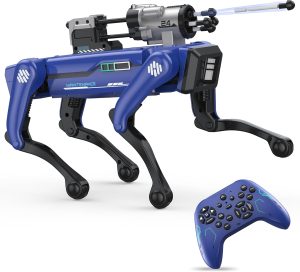Google DeepMind Revolutionizes Robotics with New AI Model

In the ever-evolving world of robotics, a groundbreaking development has emerged. Google DeepMind has released an innovative AI model known as Gemini Robotics. This new model promises to enhance robots’ ability to interact with their environment. Whether at home or in the warehouse, robots are now more capable than ever.
With the introduction of this advanced technology, we’re entering a new era of robotics. The possibilities are endless, from folding paper to packing glasses. Ensuring safety remains paramount, so DeepMind has also included a research version and a benchmark called Asimov to assess robot safety.
Gemini Robotics: A Leap in AI Innovation
Google DeepMind’s Gemini Robotics is shaping up to be a game-changer in the robotics industry. The model enhances robots’ ability to interact with objects and environments, making them more efficient in executing tasks.
In trials, robots using Gemini Robotics folded paper and packed cases effortlessly. These tasks, once considered challenging, now showcase the model’s potential to simplify complex operations in daily life.
Alongside Gemini, DeepMind introduced a research-friendly model and a safety benchmark called Asimov, setting a new standard for safe robotic operation. The implication is clear: safer and smarter robots are on the horizon.
Real-Time Gesture Control: A Step Forward
MIT and NVIDIA’s latest AI framework allows users to correct robots on the go without coding. This advancement opens doors for more intuitive interactions between humans and robots.
By simply pointing, tracing paths, or guiding the robot’s arm, users can adjust tasks instantly. Tests show this improvement raised success rates by 21% over traditional methods.
This real-time adaptability is essential for future robotics, marking a shift towards more human-like robot interactions.
Data-Driven Innovation in Self-Driving
Hugging Face and Yaak’s collaboration brought ‘Learning to Drive’ (L2D), a new self-driving training dataset into the spotlight. This dataset plays a pivotal role in improving autonomous vehicle technology.
L2D stands distinct from others by including over a petabyte of real-world driving data. This fuels AI with the capability to predict road behavior accurately. The future of safe autonomous cars now seems closer than ever.
This partnership emphasizes the growing importance of data in refining AI models, making roads safer for all.
Silk-Weaving Robot: Nature Meets Technology
A robot inspired by spiders’ silk-making abilities is making headlines in Estonia. Using a heated polymer, the robot can weave its components, creating pathways over tricky terrain.
This is groundbreaking in disaster relief scenarios, where the ability to maneuver over debris is crucial. The robot showcased paths over sharp materials, highlighting its potential impact on rescue operations.
The blend of nature and technology is paving the way for more adaptable robotics solutions, relevant in construction and beyond.
Flying Batteries for Groundbreaking Flight
UC San Diego’s engineers have tackled the issue of power for microdrones. Their new lightweight solid-state batteries provide higher voltage, enabling drones to fly longer.
The innovation called “flying batteries” works by stacking these batteries to increase voltage. It’s a neat solution for providing power without added weight.
This breakthrough promises extended flight times, revolutionizing how microdrone technology is implemented across various fields.
Robots Transforming Daily Life: New Horizons
In Japan, robot servers are operated remotely by individuals with disabilities. These ‘cyber servers’ are creating new employment avenues while offering a unique dining experience.
Meanwhile, China’s robot marathon showcases competitive humanoid robots. This event reflects the country’s commitment to robotics and innovation.
Agricultural robots are also gaining popularity, with some simplifying tasks like watering crops or feeding livestock, streamlining operations in the farming sector.
Financial Moves and Industry Growth
The robotics industry is seeing significant investments. Dexterity secured $95M for its dual-armed robots to perform complex tasks with precision.
Swiss giant ABB is investing $120M to boost production in the US, aiming to increase electrification technology availability. These steps demonstrate the industry’s ongoing expansion and adaptation to modern challenges.
Meanwhile, Shield AI’s funding aims to scale its enterprise platform, highlighting the industry’s evolution in terms of autonomy and reliability.
As robotics continue to evolve, the boundaries of what is possible are regularly redefined. With innovations like Gemini Robotics and flying batteries, the future holds immense potential.
The strides made today pave the way for a smarter, safer tomorrow. This evolution in robotics not only enhances our lives but also opens up exciting new frontiers.





